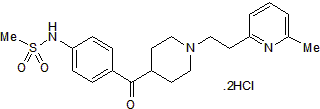E-4031 dihydrochloride
Chemical Name: N-[4-[[1-[2-(6-Methyl-2-pyridinyl)ethyl]-4-piperidinyl]carbonyl]phenyl]methanesulfonamide dihydrochloride
Purity: ≥98%
Biological Activity
E-4031 dihydrochloride is a selective blocker of KV11.1 (hERG) channels; inhibits the rapid delayed-rectifier K+ current (IKr). Reversibly prolongs action potential duration in guinea pig papillary muscle and isolated ventricular myocytes, without affecting Na+ or Ca2+ inward currents. Class III antiarrhythmic agent.Technical Data
The technical data provided above is for guidance only.
For batch specific data refer to the Certificate of Analysis.
Tocris products are intended for laboratory research use only, unless stated otherwise.
Background References
-
The binding site for channel blockers that rescue misprocessed human long QT syndrome type 2 ether-a-gogo-related gene (HERG) mutations.
Ficker et al.
J.Biol.Chem., 2002;277:4989 -
Effects of the new class III antiarrhythmic drug E-4031 on myocardial contractility and electrophysiological parameters.
Wettwer et al.
J.Cardiovasc.Pharmacol., 1991;17:480 -
Effects of the delayed rectifier current blockade by E-4031 on impulse generation in single sinoatrial nodal myocytes of the rabbit.
Verheijck et al.
Circ.Res., 1995;76:607
Product Datasheets
Reconstitution Calculator
Molarity Calculator
Citations for E-4031 dihydrochloride
The citations listed below are publications that use Tocris products. Selected citations for E-4031 dihydrochloride include:
11 Citations: Showing 1 - 10
-
Sigma non-opioid receptor 1 is a potential therapeutic target for long QT syndrome.
Authors: Song Et al.
Nat.Card.Res. 2022;1:142
-
Neurokinin-3 receptor activation selectively prolongs atrial refractoriness by inhibition of a background K+ channel.
Authors: Veldkamp Et al.
Nat Commun 2018;9:4357
-
Electrophysiological measurement of ion channels on plasma/organelle membranes using an on-chip lipid bilayer system.
Authors: Kamiya Et al.
Sci Rep 2018;8:17498
-
An Automated Platform for Assessment of Congenital and Drug-Induced Arrhythmia with hiPSC-Derived Cardiomyocytes.
Authors: McKeithan Et al.
Front Physiol 2017;8:766
-
Differentiation and characterization of rhesus monkey atrial and ventricular cardiomyocytes from induced pluripotent stem cells.
Authors: Zhang Et al.
Stem Cell Res 2017;20:21
-
Chemical-defined and albumin-free generation of human atrial and ventricular myocytes from human pluripotent stem cells.
Authors: Pei Et al.
Stem Cell Res 2017;19:94
-
Ion Fluxes through KCa2 (SK) and Cav1 (L-type) Channels Contribute to Chronoselectivity of Adenosine A1 Receptor-Mediated Actions in Spontaneously Beating Rat Atria.
Authors: Bragança Et al.
Front Pharmacol 2016;7:45
-
Cardiac sodium/calcium exchanger preconditioning promotes anti-arrhythmic and cardioprotective effects through mitochondrial calcium-activated potassium channel.
Authors: Zhang Et al.
PLoS One 2015;8:10239
-
Use of Human Induced Pluripotent Stem Cell-Derived Cardiomyocytes (hiPSC-CMs) to Monitor Compound Effects on Cardiac Myocyte Signaling Pathways.
Authors: Guo Et al.
Curr Protoc Chem Biol 2015;7:141
-
Apamin does not inhibit human cardiac Na+ current, L-type Ca2+ current or other major K+ currents.
Authors: Yu Et al.
Int J Clin Exp Pathol 2014;9:e96691
-
Characterization of hERG1 channel role in mouse colorectal carcinogenesis.
Authors: Fiore Et al.
Cancer Med 2013;2:583
FAQs
No product specific FAQs exist for this product, however you may
View all Small Molecule FAQsReviews for E-4031 dihydrochloride
There are currently no reviews for this product. Be the first to review E-4031 dihydrochloride and earn rewards!
Have you used E-4031 dihydrochloride?
Submit a review and receive an Amazon gift card.
$25/€18/£15/$25CAN/¥75 Yuan/¥2500 Yen for a review with an image
$10/€7/£6/$10 CAD/¥70 Yuan/¥1110 Yen for a review without an image

